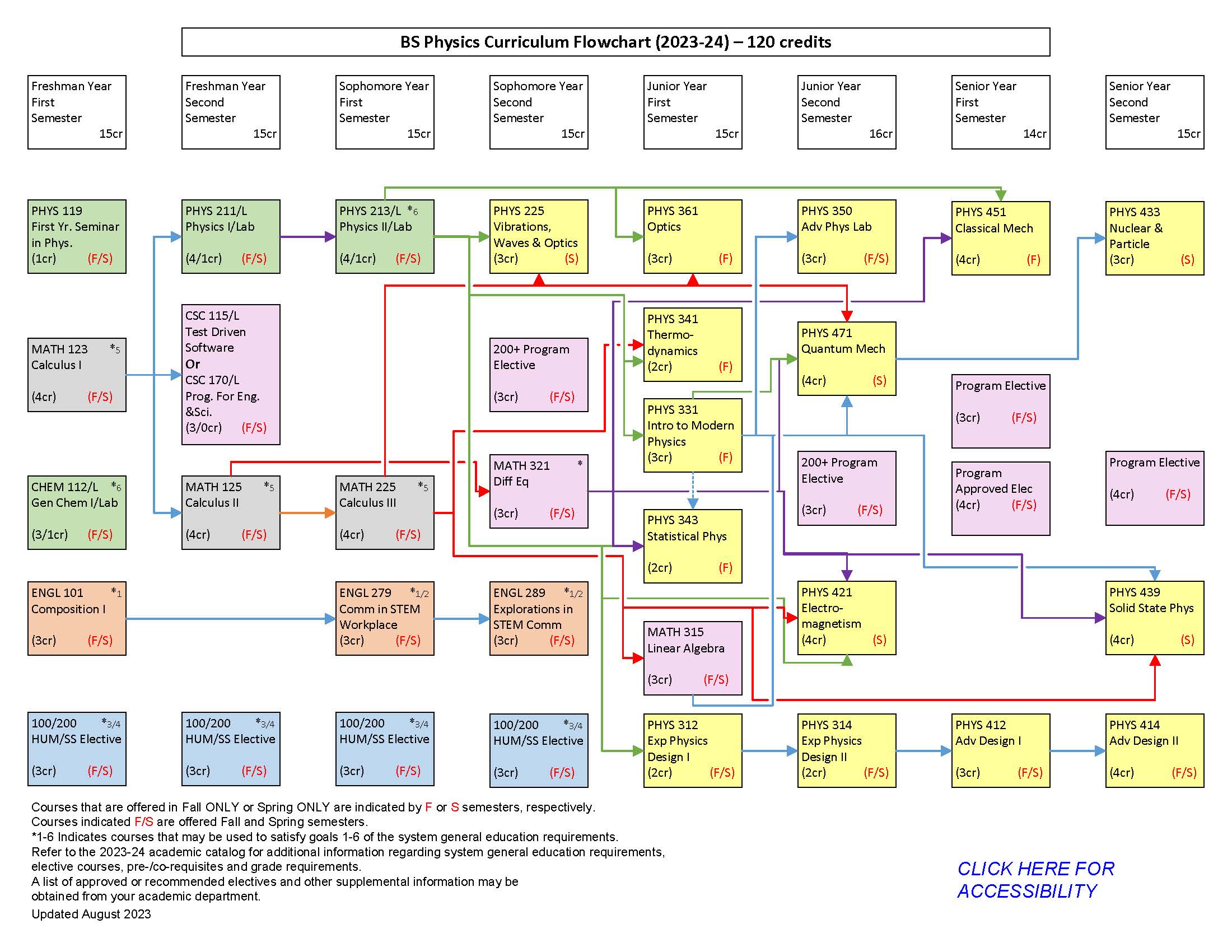| |
Dec 13, 2025
|
|
|
|
|
2023-2024 Academic Catalog [ARCHIVED CATALOG]
Physics, BS
|
|
 Return to: Undergraduate Studies Return to: Undergraduate Studies
Contact Information
Dr. Richard W. Schnee
Department of Physics
Dakota 101
(605) 394-2364
E-mail: Richard.Schnee@sdsmt.edu
Department Website
Students are responsible for checking with their advisors for any program modifications that may occur after the publication of this catalog.

PHYS Flowchart
|
Notes:
1 Fulfills General Education requirement. Students should consult the “General Education Requirements ” section of this catalog for a complete listing of all general education requirements. 2 Course is offered on a rotational basis. Contact department for questions on course offerings. 3 Select 17 credits from the list of Program Electives below. Three of the 17 credits must be in a MATH or CSC prefix at the 200 level or above. Up to 10 credits of Program Electives can be from Military Science courses. Program Electives
Select 17 credits from the following list including at least three credits of courses with a MATH or CSC prefix. Electives can be selected from more than one of the below groupings: Objectives and Outcomes
Program Objective #1: Mastery of Scientific and Technical Skills Student Learning Outcomes: - Enhanced Information Literacy: Students will demonstrate knowing when information is needed, and the ability to locate, evaluate, and effectively and ethically use scientific information from diverse sources, including peer-reviewed journals, databases, and other relevant repositories.
- Advanced Problem-Solving Proficiency: Students will demonstrate the ability to understand complex physics-related problems and design, evaluate, and implement strategies to solve them.
- Refined Inquiry and Analysis Skills: Students will demonstrate the ability to collect and analyze evidence using appropriate methodologies and to break complex topics or issues into parts to improve their understanding.
- Elevated Critical and Creative Thinking: Students will exhibit advanced skills to evaluate background information, data, methods, and implications before accepting or formulating a conclusion. Students will display the capacity to combine or synthesize existing ideas in original ways and demonstrate innovation, divergent thinking, and risk taking.
- Advanced Proficiency in Instrumentation and Data Analysis: Students will demonstrate mastery in the operation of scientific instruments, various software applications, coding languages, and data analysis techniques within the realm of physics.
Program Objective #2: Application of Physics to Problem-Solving Student Learning Outcomes: - Proficiency in Fundamental Laws and Their Applications: Students will exhibit mastery in applying foundational laws of physics in classical mechanics, quantum mechanics, electromagnetism, thermodynamics, special relativity, optics, condensed matter physics, and other specialized areas.
- Problem-Solving across Disciplines: Students will demonstrate the ability to effectively address complex problems that traverse multiple physics areas or require a multidisciplinary approach. This involves synthesizing knowledge from various branches of physics to analyze and solve real-world challenges, fostering a versatile problem-solving skill set.
Program Objective #3: Effective Communication Student Learning Outcomes: - Clear and Concise Scientific Writing: Students will proficiently articulate scientific and technical concepts in written form, employing clarity, precision, and completeness in their communication with appropriate language and proper syntax.
- Multifaceted Communication Strategies: Students will adeptly organize and present scientific ideas using diverse mediums including words, mathematical equations, tables, graphs, diagrams, simulations, and other visual aids to effectively convey complex physics concepts.
Program Objective #4: Development of Professional and Workplace Skills Student Learning Outcomes: - Enhanced Teamwork Proficiency: Students will demonstrate advanced collaborative skills through their contributions to team tasks, support of other team members, and their fostering of a constructive team climate.
- Improved Planning and Organizational Abilities: Students will exhibit enhanced capabilities in planning, organizing, and prioritizing work to achieve professional and academic goals efficiently and effectively.
|
 Return to: Undergraduate Studies Return to: Undergraduate Studies
|
|